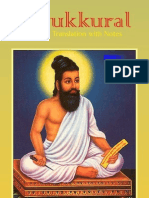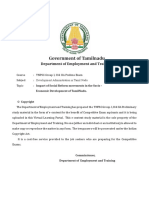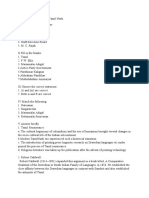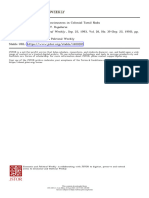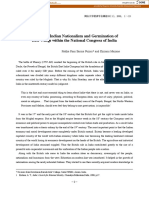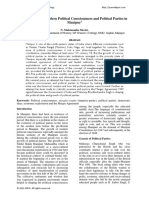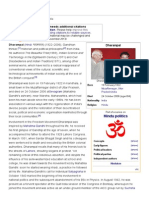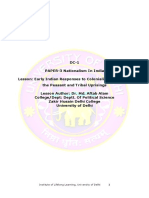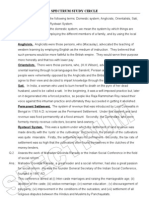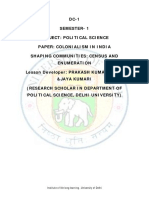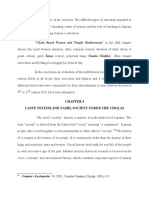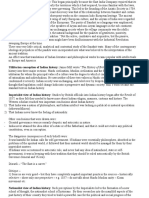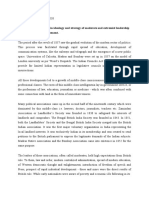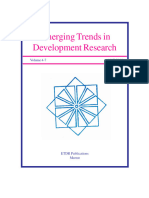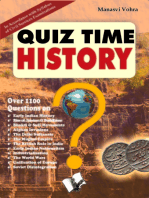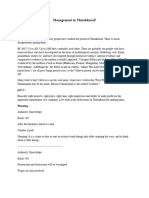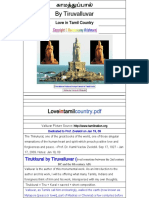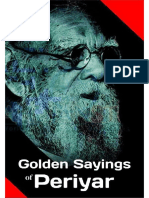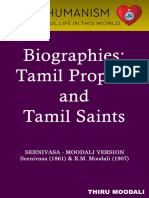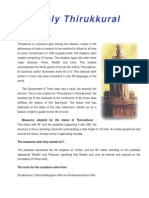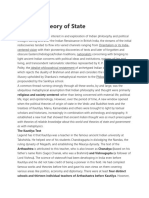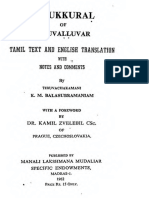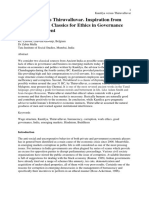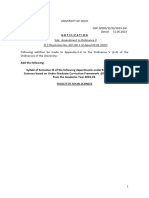TEST 20 - Social Welfare Schemes - PDF - 665bfab17c01a
TEST 20 - Social Welfare Schemes - PDF - 665bfab17c01a
Uploaded by
jeeviga153Copyright:
Available Formats
TEST 20 - Social Welfare Schemes - PDF - 665bfab17c01a
TEST 20 - Social Welfare Schemes - PDF - 665bfab17c01a
Uploaded by
jeeviga153Original Title
Copyright
Available Formats
Share this document
Did you find this document useful?
Is this content inappropriate?
Copyright:
Available Formats
TEST 20 - Social Welfare Schemes - PDF - 665bfab17c01a
TEST 20 - Social Welfare Schemes - PDF - 665bfab17c01a
Uploaded by
jeeviga153Copyright:
Available Formats
Unit -9
10thvol – II Social transformation in Tamil Nadu
(10.3 south Indian liberal federation
Social welfare (justice party)
schemes 11th political Unit – 15 Tamil Nadu political thought
science
10thvol -2
Unit – 10- Social Transformation in Tamil Nadu
Learning Objectives
To acquaint ourselves with
▪ To acquire knowledge about the social transformation of modern
Tamil Nadu
▪ To know the different social reform movements in Tamil Nadu
▪ To understand the ideas of the social reformers
Introduction
• Europeans established their political power over Indian subcontinent in the latter
half of the eighteenth century. While they were concerned with annexing India,
by the beginning of the nineteenth century they were reordering Indian society.
New revenue settlements were made. Influenced by British Utilitarian ideas and
evangelicals they also tried to impose their cultural superiority over the Indian
people. Indigenous traditions were treated as primitive. Indian society was
portrayed as conservative where human beings were discriminated on the basis
of caste, gender, language and creed.
• This caused a reaction among the Indians. During the nineteenth century,
educated Indians from different parts of the countrybegan to feel the humiliation
1 | P a g e APPOLO STUDY CENTRE PH: 044-24339436, 42867555, 9840226187
and responded by seeking their socio-cultural identity from their past. However,
they understood some merits in the colonial arguments and were ready tore
form. Raja Rammohan Roy was among the pioneers in this process. Roy and
many like him came to be known as social reformers. They were preparing a
social and cultural sphere to counter the cultural hegemony of Europe. It resulted
in the social and religious reform movements in modern India. This particular
historical development is also identified as the Indian renaissance.
• Renaissance is an ideological and cultural phenomenon. It is closely tied to
modernity, rationalism and the progressive movement of the society. Critical
thinking is at its root. A new philosophical tradition centring around human
rationality and equality is its characteristic. The basic inspiration of renaissance is
humanism and questioning the fundamentalist religious practices that denied
humans their dignity. This ideology of humanism stimulated creative energy in
all spheres of social life and knowledge such as language, literature, philosophy,
music, painting, architecture, etc.
South Indian Liberal Federation (Justice Party)
• As World War I was in progress the British government was considering the
introduction of representative institutions for Indians after the War. Fearing that
such political reforms would further strengthen the political power of Brahmins,
educated non-Brahmins decided to organise themselves politically. On
20November 1916 around 30 prominent non-Brahmin leaders including Dr. C.
Natesanar, Sir Pitti They agarayar, T.M. Nair and Alamelu Mangai Thayarammal
came together to form the South Indian Liberation Federation(SILF). In the
meantime, at a meeting held inthe Victoria Public Hall the Non-Brahmin
Manifesto was released in December 1916.The manifesto articulated the voice of
thenon-Brahmin communities and surveyed thegeneral condition of the non-
Brahmins in Madras Presidency.
• The association started publishing three newspapers: Dravidian in Tamil, Justice
in English and Andhra Prakasika in Telugu, to propagate the ideals of the Party.
The Non-Brahmin Manifesto pointed out that though “Not less than 40 out
of the 411/2millions” of the Madras Presidency were non-
Brahmins, “in what passes for the politics in Madras they have not taken the part
to which they are entitled”. Arguing that a government conducted on “true British
principles of justice and equality of opportunity” was in the best interests of India,
it declared, that “we are deeply devoted and loyally attached to British rule”.
• The first election, under the Montagu-Chelmsford Reforms, was held in 1920
after the introduction of the Dyarchy form of government in the provinces. The
Justice Party won the election and formed the first-ever Indian cabinet in Madras.
A. Subbarayalu became the Chief Minister of the Madras Presidency and the
party formed the government during1920–1923 and 1923–1926. In the context of
2 | P a g e APPOLO STUDY CENTRE PH: 044-24339436, 42867555, 9840226187
Congress Party boycotting the legislature, the Justice Party continued to remain
in office till1937 elections were held. In the 1937 elections the Indian National
Congress contested the elections for the first time and trounced the Justice Party.
Programmes and Activities
• The Justice Party is the fountain head of thenon-Brahmin Movement in the
country. TheJustice Party government widened educationand employment
opportunities for the majorityof the population and created space for themin the
political sphere. Tamil Nadu’s legacy ofsocial justice owes its existence to the
formativeyears of Justice Party in power.
• The Justicites removed the legal hindrancesre stricting inter-caste marriages and
broke the barriers that prevented Depressed Classes from the use of public wells
and tanks. The Justice Party government ordered that public schools
accommodate the children of the Depressed Classes. Hostels were established for
the students belonging to this social group in 1923. In the meantime, the Madras
legislature under the Justice Party government was the first to approve
participation of women in the electoral politics in 1921. This resolution created
space for woman and thus facilitated Muthulakshmi Ammaiyar to become the
first woman legislator in India in 1926.
• The Justice Party worked towards legislating provisions for communal
representation –reservations for various communities. Two Communal
Government Orders (16 September1921 and 15 August 1922) were passed to
ensure equitable distribution in appointments among various castes and
communities as apart of achieving social justice. The Justice Party rule
established the Staff Selection Board in 1924 for the selection of government
officials and encouraged all the communities to share the administrative powers.
In 1929,the Government of British India adopted the pattern and established the
Public Service Commission.
• The Justice Party further concentrated onre forms in religious institutions. Tamil
Nadu has a large number of temples and these commanded huge resources. In
general, the resources were monopolised and exploited by the dominant caste in
the society and led to mismanagement of public resources. The Justice Party
introduced the Hindu Religious Endowment (HRE) Act in1926 and enabled any
individual, irrespective of their caste affiliation, to become a member of the
temple committee and govern the resources of the religious institutions.
3 | P a g e APPOLO STUDY CENTRE PH: 044-24339436, 42867555, 9840226187
11thvol II
UNIT – 15-Tamil Nadu Political Thought
Historical Background
• The 'Classical Tamil homeland (Tamizhagam) is called as Tamil Nadu besides
some parts of kerala, Andhra and Karnataka; Strabo (63 BC(BCE) to c. AD(CE)
24), a famous Greek geographer and historian observed the early diplomatic
history of ancient Tamil Kingdom of Pandiyas. Naval expeditions of Cheras,
Cholas, Pandiyas and Pallavas inform early maritime power and influence of
Tamils. Ports in the coast of Tamil Nadu were important centres of trade between
India and the Mediterranean, and India and southeast Asia, in the period. 200
BC(BCE) to 300 AD(CE). The ancient ports of Korkai, Poompuhar,
Vasavasamudram, Perimula, Arikamedu, Alagankulam, Mamallapuram reveal
the active trade, commerce and cultural exchanges with the Southeast Asian
countries, Sri Lanka, China, Egypt, Greece and Rome. An established tradition of
shipbuilding combined with rich maritime heritage of ancient Tamils are definite
indicators of the foundations of influential polity, society, culture, trade and
commercial ties with the outside world.
• Sangam literature dated approximately 300 BC(BCE) to 300 AD(CE) is another
valuable literary source(s) that reflects society, economy, culture and politics. The
classification of Sangam poetry into akam (on love) and puram (on war, good
andevil, community, justice and kingdom) is a revelation of the Tamil polity. The
Sangam literary works have been grouped into eight anthologies (Ettuthogai):(1)
Natrinai, (2) Kuruntogai, (3) Aingurunooru,(4) Paditruppattu, (5) Paripadal, (6)
Kalittogai, (7)Agananooru, and (8) Purananooru; and there is a ninth group of
poems called the Patthupattu (Ten Idylls).The early part of the first two books of
Tholkappiyam, a work on Tamil grammar, belongs to the same period.
Learning Objectives
The students will be able to
❖ Learn about ancient political ideas in Tamil Nadu.
❖ State clearly the political ideas of Thiruvalluvar.
❖ nderstand about Nationalism through Bharathiyar
❖ Learn about communist ideas that existed in Tamilnadu through Singaravelar's
writings on communism.
❖ Learn and understand Dravidian Ideology and its impact on the society, polity
and economy in Tamil Nadu through the contributions of E.V.R.Periyar on
social justice, equality and liberation from oppression of higher caste.
❖ Describe clearly the core meaning of Tamil Movement and Dravidian movement
and its political discourse.
4 | P a g e APPOLO STUDY CENTRE PH: 044-24339436, 42867555, 9840226187
• The famous post-Sangam literature which was collected later as an anthology is
known as the Kilkkanakku. There are 18 works as part of this collection and the
most famous is Silappadikaram, Manimekalai and Eighteen Minor Works
(Pathinenkilkkanakku, which includes the Thirukkural) were written during this
period. Prabandha literature consists of poetry of various forms: kovai, in which
the verses are arranged according to a particular theme (usually about love), and
kalambakam, in which the end of one stanza/line formed the beginning of the
next (usually about kings and bravery) and parani. The best illustrations of this
tradition are the Pantikkovai, Nandikkalambakam, and Kalingattup-parani.
• The ancient Tamil literature of Sangam age, Thirukkural, Silapathikaram,
Manimegalaietc provide deep insights into the nature of polity, society and
culture. Tamil language formed the core and essence of Tamil identity, culture,
customs and traditions. Despite the diversity of land, geography, rulers and
chieftains spread across the Tamil speaking areas the idea of Tamil country and
confederation of Tamil speaking areas did exist. This literary finding(s) is also
substantiated by a stone inscription of Kalinga King Kharavela (BC(BCE) 165),
whoclaims to have destroyed a ‘Tamil federation’ which existed for 132 years.
Similarly such a Tamil federation of kings to fight foreign invasion is also
mentioned in ‘Agananooru’, a sangam literature. Hence the idea and prevalence
of Tamil nationalism is not simply a consequence of colonialism. The roots of
Tamil nationalism are linked to the historical role and significance of Tamil
language and culture in defining politics that could be traced even in the Sangam
age.
• The concept of State and the idea king coincided with the territorial emphasis of
polity as the Greek city-state. The classical Tamil country known as Tamizhagam
covered areas south of Tirupati hills up to the tip of the Cape Comorin
(Kanyakumari). The land was traditionally classified according to its nature into
five geographical regions (tinai): the mountainous region (kurinji), the forest
areas(mullai), fertile plains (marudam), coastal region (neidhal) and arid region
(palai).
• Tamil speaking areas were divided between the principalities of the Cholas (its
capital at Uraiyur), the Pandyas (Madurai as capital), the Cheras in most of
present Kongunadu (and Kerala) and the Pallavas (Kanchipuram as capital).
Tamil country included several kingdoms ruled by kings (vendhar), major and
minor chieftains (vel/velar) who was less powerful than the crowned kings. The
Sangam poets sang songs of praise about the velirs, especially the Seven Patrons,
for their generosity towards the poets. Kapilar and Avvaiyar mention chieftains
like, Aay, Pari, Ori, Malayan, Elini, Pegan and Nalli..
• The virtues of king did include the ideals of Just Ruler with qualities of kindness
towards the subjects and bravery in the battlefieldagainst enemies. The sabhai or
mandram was the highest court of justice presided by the king himself. Every
village had its own mandram which met at a common public place and was
5 | P a g e APPOLO STUDY CENTRE PH: 044-24339436, 42867555, 9840226187
involved in organizing village and community activities. Warriors were
respected, and a man who died in battle would have memorial stones erected in
his honour and be worshipped in death. Even if a warrior dies in battle field with
a wound in his back, it is considered derogatory in ‘Sangam’ traditions.
In praise of Citizen Kannagi
Eric Miller
Kannagi proved that even a non-native with no money and no family insight
can fight City Hall and win her casethat is inspiring.
• I write in praise of Kannagi,global symbol of justice, andof the dignity of
theindividual!
• This isher story theSilappathikaram, the Epic of theAnklet as I know
it:Kannagi and Kovalan marriedin Poompuhar, on the eastcoast. After some
time,Kovalan went off with a dancernamed Madhavi. A year later,he returned
home. He andKannagi walked to Madurai,a distance of about 250 km, tostart a
new life. There Kovalanwas unjustly put to death by thelocal ruler, the Pandian
king:Kovalan had been falselyaccused of stealing thequeen’s anklet.
Kannagicame to the court andproved that her husband hadbeen innocent of this
crime. The kingpunished himself for the injustice he haddone, by simply laying
himself down and dying. Kannagi walked around the city three times, tore off
her left breast and threw it against the city wall, and calledfor the city to burn but
for good people and animals to be u nharmed. Agni, the god of Fire,
accomplished this. Kannagi wandered to the western mountains, where some
people worshipped her. Eric Miller did his Ph.D. in Folklore, University of
Pennsylvania, USA. His dissertation is on Tamil children’s songs and games, and
language learning. To conduct research on the Silappathikaram, he walked in the
footsteps of Kannagi from Poompuhar,to Madurai, to the western mountains.
Quotes are from R. Parthasarathy’s translation from the original sen-Tamil: The
Silappatikaram: The Tale ofan Anklet, by IlankoAtikal, Columbia University
Press, 1993.)
Extended Learning
Refer The Hindu website and read the article by Eric Miller. Share your views
in the classroom.
• Lots of good practices of war find its mention in sangam literature. Purananooru,
a sangam literature, hails the Pandyan king who announces all the women,
children, sick and elderly people, cattles, to move to safety zone before invading
a country. The idea of justice formed the conscience of State and king. Justice is
an essential element in a king’s rule. A good king should never sacrifice justice.
6 | P a g e APPOLO STUDY CENTRE PH: 044-24339436, 42867555, 9840226187
Just rule and good deeds always will bring everlasting fame to the king. An
important political principle that prevailed was that
• (Despite the nature of political system being monarchy) the legitimacy of the king
rests with the consent of the people as long as he enjoys people’s support and he
loses legitimacy if he loses their support. Sangam literature (Pattinappaalai)
speaks about different types of taxations like customs duty, income tax, toll tax
etc as specific source of revenue to the State. Tamil kings and chieftains ruled the
land with simple administrative structure of council of ministers, subordinates
and administrative officers. There were officers to deal with foreign trade and
customs revenue which was an important part of the budget. Pandya inscriptions
mention about officers for pearl fisheries (kalatika) and the chief scribes
(kanatikan). In flags and coins,the Cholas were represented by the tiger, the
Cheras by the bow and arrow the Pandyas by the fish and the Pallavas by the
lion.
• The institution of ‘spy’ was considered as a necessary institution and the
maintenance of peace and stability in the kingdom depended on the effectiveness
of this institution. Though slavery as a form of institution was absent yet
capturing of slaves after invasions, and slave trade or exchange for gifts did
remain as practice among the rulers to undertake construction and building
works.
• The practice of caste system or jati was unknown among ancient Tamils. The idea
and concept of class with differences in status based on professional distinctions
did prevail. The caste system was alien and unknown to Sangam society. The
division of society based on class has been revealed by the Sangam poets who
mention about social categories (kudi): tudiyan, panan, and kadamban; or arasar
(rulers), vaishyar (traders), and velalar (farmers). Differences in status were
accepted as inevitable, yet varna in the form of caste or jati seems to be little
known to Sangam society.
• Though social stratification did prevail yet legitimization of Manusmiriti or
Aryan-Brahminical interpretation of caste as divine arrangement was not integral
to the cultural universe or worldview of the ancient Tamils. The beginnings and
early inroads of the Aryan-Brahminical account of caste could be traced to later
period of Sangam era. The ancient religion of Tamils was based on folk
traditions. The worship of nature and natural elements were more common. The
worship of Murugan among the tribes of Tamil Nadu and the cult worship of
Murugan as the warrior God was based on folk culture. An earthly
compositionof God is rooted in the Tamil – Dravidian traditions. It was only after
the sixth century AD(CE), inscriptions were written in Tamil as well as Sanskrit.
Sanskritisation gradually spread to public space with the evoking of the doctrines
of benevolence to Brahmin(s) and divine blessings to the king .
7 | P a g e APPOLO STUDY CENTRE PH: 044-24339436, 42867555, 9840226187
• The seeking of blessings from the Brahmin soon became a source of legitimacy
for the Tamil king after this period. Along with the Sanskritisation, Vedic rituals,
worship and orientation to social (caste) system as advocated in Manusmiriti
found their passage to transform the professionally stratified class structure of
Dravidian society into a hierarchically classified social (caste) system with Vedic
divine sanctions.
• The State and king were being seen as one and the same. The hereditary principle
and evoking of divine rights with earthly symbols were prevalent among the
Tamil kings. The idea of territorial State provided inherent reconciliation to the
changing dynasties and geographical changes as boundaries of principalities
were drawn and redrawn. The governing principles of power and location of
monarchy also moved from culture specific to power centric based on authority.
Thus in later period, during the post-Sangam era, the king gradually became the
sole source of authority.
• The Pallavas maintained that as they were the descendants of Brahma, the
kingship was of divine origin and was hereditary. The Pallava period witnessed
the penetration of the Aryan culture of North India into the South as well as the
assimilation of some of the patterns, ideas and institutions and rejection or
modification of certain other aspects. Tamil devotional culture was one ofthe
results of this interaction as revealed by the themes and dedication of deity at
temples.
• Women were highly respected and performed a variety of jobs and duties
including as bodyguards to the kings, yet power and authority rested with men.
Women participated in public assemblies but rulers and administrators were
mostly men. Women formed significant part of social rituals and functioned as
pivots of the family despite the inheritance rights and formal authority remained
with men.
• In narrating the role and status of women in Tamil society we need to mention
about the tradition of Avvaiyar (meaning respectable women). More than a
name, this was a title, literary canon, given to distinguished women who made
contributions to Tamil literature. There were as many as four to six women who
held this Tamil literary canon title at different times based on different sources.
• Avvaiyars of Sangam age and Cholas age are best known for their extraordinary
influence upon literature, culture, moral universe, nature of polity, war, peace
and the art of diplomacy. Sangam age Avvaiyar lived during the 1st and 2nd
century AD(CE). King Athiyaman NedumanAnchi of the Velir Dynasty was her
chief patron and considered as contemporary of literary legends Thiruvalluvar
and Kabilar with notable contribution of verses in Natrinai, Kuruntogai,
Akananooru and Purananooru. She is also credited as the most gracious and
scholarly diplomat who undertook diplomatic missions for King Adhiyaman
Neduman Anchi. Avvaiyar, a poetess and friend of King Adhiyaman, ruler of
8 | P a g e APPOLO STUDY CENTRE PH: 044-24339436, 42867555, 9840226187
Tagadur, is supposed to have helped in avoiding war between two kingdom
states.
• King Thondaiman, ruler of Kanchipuram, had sent him a note declaring his
intention to attack ThagadurAvvaiyar spoke “Oh Thondiaman, how different
indeed are your clean and shiny weapons from those of Adiyaman, always
stained with blood and under repair.”
• Thondaiman had far less experience in war and was unlikely to win — she was
making this clear under the guise of praise. Another famous Avvaiyar was from
the Cholas age, around 10thCentury AD(CE), who wrote moral universe for
children and advocated ethical principles for all. Whilst her works Aathichoodi
and Konraiventhan werewritten for young children, Mooturai andNalvazhi were
written for older children.
Thirukkural
• All these classical works not only reveal the cultural and literary traditions of the
ancient Tamils. They also serve as historical testimony to the nature of Tamil
society, socio-cultural and religious beliefs, livelihood, vocations, professions,
role and status of women, marriage, gender, class structure, origins of caste
system, kinship, polity, governance, ideas of justice, wars, peace, diplomacy,
naval warfare, maritime traditions, trade, commerce, shipbuilding and seafaring
skills, economy, land, water systems, agriculture, art, dance, poetry, music,
architecture and relationship with the neighbouring countries and far away
places.
Introduction
• Politics intends to create change-oriented awareness in the society. It is
notnecessary to adopt and follow the existingsocial system which the present
politics do.This awareness can be initiated by ideas andideologies of society-
laden thinkers.
• With the advancement of civilization to the next stage through socio-economic
and technocratic developments, emerging new ideas got stumbled by the existing
belief system and functions followed until now. Albeit of these stumbling blocks,
the constructive impact made by the thinkers and thinking is ever-lasting on the
basis of mind-capturing of the people. Ideas are dangerous than the technocratic
revolution, positively.Quite apart, pen is more powerful than sword.
9 | P a g e APPOLO STUDY CENTRE PH: 044-24339436, 42867555, 9840226187
In your note draw three columns as given in the text book
POLITICS
what I know? what I want to know? what I have learnt?
Th e definite part of thinkers is as follows:
❖ Being the basis for the social changes and subsequent events including the
change in the public minds;
❖ Having taken political decisions which had an impact on social turning points;
❖ Serving as best brains behind the major political decisions which has benefitted
the diversified communities;
❖ To convert social ideas into common which assisted people’s advancement
belonging to various communities
• New political ideas are supported by the activities of the political thinkers which
kindles interest and rational thinking of the common people. The interaction of
those thinkers with the contemporary society makes a new framework for the
entire system.New political decisions which intend to create great changes for the
emerging generations were undertaken.The day-to-day life of common people
may be engulfed with many changes by the political decision of the thinkers.At
world level these kind of thinkers made changes in the socio-political systems.
Such great thinkers made their extra-ordinary presence throughout the past
centuries in India in general and Tamilnadu in particular.
• National political thinkers, Tamil political thinkers, Socialist thinkers, Thinkers of
social justice are the different parts of modern categorization. In this part we can
discuss about different political thinkers of Tamilnadu who made out-standing
contribution for the social changes.
• Political ideologies in Tamilnadu is rich with ideas, beliefs, opinions and
attitudes towards society, polity and economy. This is evident from the ancient
political ideas of Thiruvalluvar, where asBharathiyar is a nationalist and
Singaravelar is a communist. According to periyar, Dravidian ideologyfocuses on
social justice. The political ideologies in Tamil Nadu are a combination of all
three left, Right and centre ideologies.
Ancient Political Ideas Thiruvalluvar
• In Arathupal of Thirukkural, Valluvarwas a great enunciator of morals;
InInbathupal, he has become a poet andin Porutpal, he is known to be a
politicalphilosopher. The political philosophy of Thiruvalluvar is applicable
across times even today.
10 | P a g e APPOLO STUDY CENTRE PH: 044-24339436, 42867555, 9840226187
Seven Parts in Porutpal
• Porutpal consists of 7 parts, further ithas 70 verses / couplets. They are Politics-
25,Ministry-10, Defence-2, Wealth-1, Army-2,Friendship-17, and citizens-13
respectively.
“ ்றைகுடிகூழ்அைமச்சுநட்்ரண்ஆறும்
உறைெ்் னஅெரருள்ஏறு“ (குற்ள்: 381)
“ An army, people, wealth, a minister, friends, fort; six things
Who owns them all, a lion lives amid the kings”
(Kural: 381)
• Thus, in porutpal, at the first verse itselfvalluvar differentiated the six
categoriesessential for a state. Thus, different partsof government are ministry,
army, wealth, people, friendship and citizens, which determines the rule of a
king. Moreover, these components are categorized for king in a separate way,
thus contributing a lot of ideas regarding administration of a state and assets for
a king.
Nature of a king – 25 Chapters
• In porutpal, Valluvar mentioned about nature of a king in detailed manner in 25
chapters starting from Qualities of ruler (Iraimatchi – chapter 39) to
idukkanazhaiyaamai (Unfazed in the face of trouble – chapter 63) in 25 chapters,
in the name of “Arasar”, “Vender”, “NilanAandavar” “Mannavar” he has
indicated 46 times about the king.
• The King must possess the leadership qualities such as, Education (40), Listening
Ability (42), Wisdom (43), Fending off Faults (44), Seeking the company of great
men (45), Avoiding mean–minded (46) Rationality (47), Priority for time for
action (51), Assessing and Assigning tasks (52), Embracing the Kin (53), Doing
duty without forgetting (54), Justice (55), Knowing the right place (50), Refraining
from Terrifying Deeds (57), Compassion (58), Espionage (59), Spirit (60), To avoid
laziness (61), Perseverance (62) and Determination (63) which should be the
requisites of a king. These above-mentioned qualities may also be possessed by
good people.
Ideas on Democracy
• Valluvar lived in the period of monarchy. However, his ideas and ideals are also
applicable for the present leaders of democracy. He also indicated the nature of
state and government in the king’s rule. Thewords of Valluvar regarding
11 | P a g e APPOLO STUDY CENTRE PH: 044-24339436, 42867555, 9840226187
governmentand state is applicable and suitable to all over the period as well as
every organization in the world.
Welfare state and King
• To put it in simple words, Valluvar’s political system is based on welfare state.
For instance, in Iraimatchi (Qualities of a ruler), he says
முறைெெய்துக ப்ப ற்றும்மன்னவன்மக்கட்கு
இறைெென்றுறவக்கப்படும். (குைள்: 388)
Who guards the realm and justice strict maintains,
That king as god over subject people reigns.
(Kural: 388)
• If a king delivered justice by doing the duties honestly, he may be regarded as a
God. Ideal path and welfare – arrived kings can be respected and kept on par
with divine. This kind of view is not only applicable to monarchical period but it
also applicable to present democratic period.
Features of State
• The characteristics of a state is to maintain ethics, the eradication of wrong doing
activity, mandating impartiality of justice and protection of honour.
அைனிழுக்க தல்லறவநீக்கிமைனிழுக்க
ம னம்உறைெதரசு (குைள்: 384)
Kingship, in virtue failing not, all vice restrains,
In courage failing not, it honour’s grace maintains.
(Kural: 384)
• King’s path is the peoples’ path, king should act as a guide for his subjects, if he
does harm or evil activities, it may influence all. It is because of his position as a
leader, his discipline and private life will spreadto all in the kingdom. Moral and
ethical life is quite essential for the ruling kings. Indicating “Respect” in a broad
manner relating it with nation, Valluvar gave priority for great honour which
may be equated with the courage. He stressed that king must be loyal to the
nation, it is the honour of nation.
Ideal State and Welfare of people
• In the monarchical rule, the integrity and ideal governance for all periods were
advocated by Valluvar. People of all regions expect rain for their growth;
likewise, citizens of a nation expect integrity and ideal rule of the king.
12 | P a g e APPOLO STUDY CENTRE PH: 044-24339436, 42867555, 9840226187
வ ன�ோ் க்கிவ ழும்உலெகல்ல ம்மன்னவன்
க�ோ் ல்ோந க்கிவ ழுங்குடி. (குைள்: 542)
All earth looks up to heaven where raindrops fall;
All subjects look to king that ruleth all.
(Kural: 542)
• In this couplet Valluvar indicates “Kol” as ideal rule which not only applies for
monarchy but also for democracy.
குடிதழீஇக்க�ோ் ோல ச்சும்ம நிலமன்னன்
அடிதழீஇநிற்கும்உலகு. (குைள் 544)
Whose heart embraces subjects all, lord over mighty land
Who rules, the world his feet embracing stands.
(Kural: 544)
• This means that for a King, who protects his citizens with love and affection, his
feet will be embraced by his subjects with love. This is an everlasting phrase
propounded by Valluvar related to good governance.
Against Tyranny
• In the chapter “Kodungonmai”, (Cruel Scepter) Valluvar explained it in negative
words. The suppressive and exploitative rule of evil king may kindle unknown
andindefinite agonies among the people. Those tears are most powerful and may
annihilate the entire kingdom.
அல்லற்பட்டுஆற்ை துஅழுதகண்ண ீரன்ோை
ெெல்வத்றதத்ோதய்க்கும்பறை (குைள் 555)
His people’s tears of sorrow past endurance, are not they
Sharp instrument to wear the marches wealth away.
(Kural: 555)
• Sad tears of suffering citizens may dethrone and destroy the entire government,
says Thiruvalluvar. Tears were equated with army, thus Valluvar’s visualization
stands unique among others.
• Autocrats and Dictators like Hitler, Mussolini and Czar were the negative players
for whom, Thirukkural served as a funeral sound.
Government’s Budget
13 | P a g e APPOLO STUDY CENTRE PH: 044-24339436, 42867555, 9840226187
• A king should be an able handed administrator in increasing the income of
government. Further he should be an expert in handling the budget.
In Iraimatchi, he said,
இெற்ைலும்ஈட்ைலும்க த்தலும்க த்த
வகுத்தலும்வல்லதரசு. (குைள் 385)
A king is be who treasure gains, stores up, defends,
And duly for his kingdom’s weal expends.
(Kural: 385)
• At first point, a king should search for the different sources of income. For this,
he calls it as “Iyatral”. Then, the second point is that, all such resources should be
put together, which is called as “Ettal”. Third, the resources thus collected must
be protected with all precautionary measures which is called as “Kaathal”
• Fourth one, is most important (i.e) allotting the resources to various sectors for
the welfare of the people, this he called it as “Vagutthal”. Thus iyatral, eetall,
kaathal and vaguthal are the four ways of utilizing the income to be expertise by
the king of nation. It is a primary duty of the king.
• These innovative and practical ideas were accepted by political and as well as
economic exponents as the basic idea of socialistic society.
Relevance of Thiruvalluvar
• The Educational qualities that are indicated by Valluvar for a king may also
apply to the citizens. Thus, he used the words “IdukkanAriyamai”, “Kalvi” for
“VazhumUyirku”, “Maandharkku” which is for all the people.
• The political ideas advocated by Valluvar in porutpal highly circumvent around
morals and noble principles. “People’s-welfare” is the basic foundation of his
contribution.
• To put it in a different way, Valluvar’s contribution to politics is applicable to the
present democratic governance for the welfare of all the people.
• The qualities that were indicated by Valluvar for a king may also apply to the
citizens. Thus, he used the words “IdukkanAriyamai”, “Kalvi” for
“VazhumUyirku”, “Maandharkku” which is for all the people.
• The political ideas advocated by Valluvar in porutpal highly circumvent around
morals and noble principles. “People’s-welfare” is the basic foundation of his
contribution.
14 | P a g e APPOLO STUDY CENTRE PH: 044-24339436, 42867555, 9840226187
• To put it in a different way Valluvar’s contribution to politics is majorly
applicable to the present democratic governance for the great welfare of all the
people.
Thirukkural – A truly secular book
• The very first observation about the Kural is the fact that it is a secular
book.During the days of Valluvarmany religion existed in India. There were
Buddhists, Jains,Sikhs, Hindus as well as agnostics and atheists. But secularism
as a concept was unknown. Valluvar himself was a believer and he has devoted
one chapter to praise of God. He must have observed a particular religion. But in
his book he advocates no religion, he does not even refer to any religion.
• The ancient Indian law-giver Manu and the ancient Greek philosophers Plato
and Aristotle maintained with absolute certainty that human begins were not
born equal. This popular view is accepted in all civilizations over centuries.
Valluvar, the philosopher poet, held a radically different view. He says:
“ All human beings are equal by birth; but differ as regards characteristics
because of the different qualities of their actions.” (Kural 972)
Nationalism SubramaniyaBharathiyar (1882 – 1921)
We shall not look at caste or religion, All human beings in this land,whether
they be those who preach the vedas or who belong to other castes are one.
-SubramaniyaBharati
• C. SubramaniyaBharathiyar was a poet, freedom fighter and social reformer from
Tamil Nadu. He was known as MahakaviBharathiyar and the laudatory epithet
Mahakavi means a great poet. He is considered as one of India’s greatest poets.
His songs on nationalism and freedom of India helped to rally the masses to
support the Indian Independence Movement in Tamil Nadu.
Bharathi: A poet and a Nationalist
“We may have thousand ofsects; that, however, does notjustify a foreign invasion.”
• Significantly, a new age in Tamil literature began with SubramaniyaBharathi.
Most part of his compositions are classifiable as short lyrical outpourings on
patriotic, devotional and mystic themes. Bharathi was essentially a lyrical poet.
“KannanPattu” “NilavumVanminumKatrum” “PanchaliSabatam” “KuyilPattu”
are examples of Bharathi’s great poetic output.
• Bharathi is considered as a national poet due to his number of poems of the
patriotic flavour through which he exhorted the people to join the independence
15 | P a g e APPOLO STUDY CENTRE PH: 044-24339436, 42867555, 9840226187
struggle and work vigorously for the liberation of the country. Instead of merely
being proud of his country he also outlined his vision for a free India. He
published the sensational “SudesaGeethangal” in 1908.
Bharathiyar's "PanchaliSabatham" (The vow of Draupadi) is an iconic work
that pictures India as Draupadi, the British, the Kauravas and the freedom fighters as
Pandavas. Through Draupadi’s struggle, he euphemised the struggle of mother
India under British rule.
Bharathi as a Journalist
• Many years of Bharathi’s life were spent in the field of journalism, Bharathi, as a
young man began his career as a journalist and as a sub-editor in
“Swadesamitran” in November 1904.“India” saw the light of the day in May,
1906. It declared as its motto the three slogans of the French Revolution, Liberty,
Equality and Fraternity. It blazed a new trail in Tamil Journalism. In orderto
proclaim its revolutionary ardour, Bharathi had the weekly printed in red paper.
“India” was the first paper in Tamil Nadu to publish political cartoons. He also
edited and published 'Vijaya', a Tamil daily “BalaBharatha” an English monthly,
and 'Suryothayam' a local weekly of Pondicherry.
• It is not surprising therefore that soon a warrant was waiting at the door of the
“India” office for the arrest of the editor of the magazine. It was because of this
worsening situation in 1908 that Bharathi decided to goaway to Pondicherry, a
French territory at that time, and continue to publish the “India” magazine.
Bharathi resided in Pondicherry for sometime to escape the wrath of the British
imperialists.
In Madras, in 1908, he organised a mammoth public meeting to celebrate
‘Swaraj Day’. His poems ‘VantheMatharam’, ‘EnthayumThayum’, ‘Jaya Bharath’
were printed and distributed free to the Tamil People.
• SubramaniyaBharathiyar was born on 11th December 1882, in a village called
Ettayapuram in Tirunelveli District in Tamil Nadu and his childhood name was
Subbiah. His father was Chinnaswamy and his mother was Lakshmi Ammal.
• At the age of seven, he started writing poems in Tamil. When he was eleven, he
wrote in such a way that even learned men praised him for his great knowledge
and skill. In the eleventh year, Subbiah felt that he had to establish his
credentials. He threw a challenge to the eminent men in the assembly of scholars
that they should have a contest with him in a debate on any subject without any
previous notice or preparation. The contest was held at a special sitting of the
Ettayapuram Durbar at which the Rajah (the ruler) himself was present. The
subject chosen was “Education”. Subbiah efficiently won the debate. This was a
memorable moment in Subbiah’s life. The boy who was till then referred to as
“EttayapuramSubbiah” came henceforth to be known as “Bharathi”, and later he
16 | P a g e APPOLO STUDY CENTRE PH: 044-24339436, 42867555, 9840226187
was respectfully referred to as “Bharathiar” by nationalists and by millions of
Tamil lovers all over the globe.
• In June 1897, Bharathi was hardly fifteen when his marriage took place, and his
bride was Chellammal. Bharathi left for Benaras which was also known as Kashi
and Varanasi. He spent there the next two years with his aunt Kuppammal and
her husband Krishna Sivan. Speedily gaining a fair knowledge of Sanskrit, Hindi
and English, he duly passed with credit the Entrance Examination of the
Allahabad University. The Banaras stay brought about a tremendous change in
Bharathi’s personality. Outwardly, he sported a moustache and a Sikh turban
and acquired a bold swing in his walk.
• During his exile, Bharathi had the opportunity to mingle with many leaders of
the militant wing of the independence movement such as Aurobindo, LajpatRai
and V.V.Subramaniam who had also sought asylum in the French ruled
Pondicherry. The most profitable years of Bharathi’slife were the ten years he
spent in Pondicherry. From Pondicherry, he guided the Tamil youth of Madras to
tread in the path of nationalism. This increased the anger of the British towards
Bharathi’s writings as they felt that it was his writings that induce and influence
the patriotic spirit of the Tamil youth. Bharathi met Mahatma Gandhi in 1919 in
Rajaji’s home at Madras. Bharathi entered British India near Cuddalore in
November 1918 and was promptly arrested. Even in prison, he spent his time in
writing poems on freedom, nationalism and country’s welfare.
• In his early days of youth he had good relations with Nationalist Tamil Leaders
like V.O.Chidambaram, Subramanya Siva, MandayamThirumalachariar and
Srinivasachari. Along with these leaders he used to discuss the problems facing
the country due to British rule. Bharathi used to attend the Annual sessions of
Indian National Congress and discuss national issues with extremist Indian
National Leaders like Bipin Chandra Pal, B.G. Tilak and V.V.Subramaniam. His
participation and activities in Benaras Session (1905) and Surat Session (1907) of
the Indian National Congress impressed many national leaders about his
patriotic fervour. Bharathi had maintained good relations with some of the
national leaders and shared his thoughts and views on the nation and offered his
suggestions to strengthen the nationalist movement. Undoubtedly, his wise
suggestions and steadfast support to the cause of nationalism rejuvenated many
national leaders. Thus Bharathi played a pivotal role in the freedom of India.
Bharathiyar as a social reformer
• Bharathi was also against caste system. He declared that there were only two
castes-men and women and nothing more than that. Above all, he himself had
removed his sacred thread. He had also adorned many scheduled caste people
with sacred thread. He used to take tea sold in shops run by Muslims. He along
17 | P a g e APPOLO STUDY CENTRE PH: 044-24339436, 42867555, 9840226187
with his family members attended church on all festival occasions. He advocated
temple entry of Dalits. For all his reforms, he had to face opposition from his
neighbours. But Bharathi was very clear that unless Indians unite as children of
Mother India, they could not achieve freedom. He believed in women’s rights,
gender equality and women emancipation. He opposed child marriage, dowry
system and supported widow remarriage.
His meeting with Sister Nivedita, Swami Vivekananda’s disciple, added
women’s rights to his already wide repertoire of social issues from caste to
Independence to spiritualism. He took up the symbolism of Shakthi as the image of
modern women; powerful, strong, independent and equal partners to men.
“World will prosper in knowledge and intellect, if both men and woman are
deemed equal.”
-SubramaniyaBharathiyar
Bharathiyar – A Visionary
• Bharathi as a poet, journalist, freedom fighter and social reformer had made a
great impact not only on the Tamil society but also on the entire human society.
He followed what all he preached and it is here that his greatness is manifested.
His prophecy during the colonial period about the independence of India came
true after two and half decades after his demise. His vision about a glorious India
has been taking a shape in the post-Independence era. Bharathi did not live for
himself but for the people and nation. That is why he is respectfully called as
Bharathiyar. Even today, after many decades, SubramaniyaBharathiyar stands as
an undying symbol of Indian freedom and vibrant Tamil nationalism.
Bharathiyar passed away on 11th September 1921.It was a travesty that only
14 people attended his funeral, fearing repercussion from the British and caste
ostracisation.
• The emergence of Swadeshi and Home rule movement in India in the initial part
of 20th century aroused the thirst for freedom. Reforms were made in Hindu
religion in accordance with the existing society. These movements played a key
role in creating the feeling of Indiannes and Nationalism in the political Scenario.
• But these movements are religious in nature. Moreover, those who participated
in these movements are from upper social class. Freedom sought by these people
are political in nature neglecting the interests and economic upliftment of farmers
and labourers. This affected the majority Indians who are poor and belong to
farmers community. Further, caste discrimination existed within Congress Party.
Particularly, in Tamilnadu there existed a clear difference between brahmins and
non-brahmins.
18 | P a g e APPOLO STUDY CENTRE PH: 044-24339436, 42867555, 9840226187
• In this context, Singaravelar played a pivotal role in spreading rational ideas and
scientific perception in to politics. He also played a key role in connecting welfare
of farmers and workers in to freedom struggle and spreading socialist thinking in
to politics.
19 | P a g e APPOLO STUDY CENTRE PH: 044-24339436, 42867555, 9840226187
Impact of Singaravelar’s Ideas on Congress Party
• The British empire which exported the raw materials in the initial stages started
industries later in India as the demand increased. This worsened common
people’s life standards. They are ready to work even for meagre wages. Hence,
those who are employed were treated as slaves. Even a minor protests by the
employees were suppressed with iron hands. More labour organizations
emerged to protect the rights of working class. These organizations were headed
by Thiru.V.Kalyanasundaranar and D.Varadharajalu in the Madras presidency. It
was Singaravelar who took major efforts in the emergence of labour
organizations in Madras presidency.
• Singaravelar wanted to sensitize the workers on politics and wanted to engage
them in the freedom struggle. But Congress Party did not accept this idea of
Singaravelar. Singaravelarcritised it vehemently and send telegraphs to Congress
high command, following this, he wrote a letter to Mahatma Gandhi. Further, he
also wrote about this issue on the popular dailies Swadesamitran, The Hindu,
and magazines like Navasakthi. He also propagated this among congress
workers. In this juncture, he participated in the Congress Committee (1922)
meeting as a representative of Tamilnadu, there also he explained the following
demands and sought support from Congress members.
™™
❖ Indian freedom includes economic freedom of workers and farmers.
❖ The welfare of farmers and labourers should also be the motto of Congress
party.™™
❖ Farmers and labourers must be included in the Indian national movement.™™
❖ Congress leaders should help to raise masses from different organization.
• In consequent with this, in 1922, Indian National Congress, passed a resolution to
raise people from various organizations. A six member committee was
constituted, in which M. Singaravelar was appointed as a member. In addition to
this, he also fought for the protection of labour rights. He emphasized this
demand by writing in all popular dailies. As an outcome, labour protective law
was passed in 1926, in India. Moreover, he advised for speaking in vernacular
languages. Only then, he believed that the ideas will reach all the people. So, that
leaders and people can maintain good relations. He is also determined to speak
in Tamil, when speaking about the issues of Tamilnadu people.
• In 1918, a resolution regarding this was passed during Chennai Presidency
Association Conference. Singaravelar and Periyar were the dignitaries in this
conference.
20 | P a g e APPOLO STUDY CENTRE PH: 044-24339436, 42867555, 9840226187
Singaravelar’s Impact on Self-Respect and Communist Movements:
• When Periyar resigned from Congress Party citing the existence of Brahmin and
Non-Brahmin divide and discrimination in the party, Singaravelar supported the
action of Periyar. After visiting USSR, Periyar was influenced by the Communist
ideals. He changed the name of self-respect movement to Self-Respect Social
Justice Party. Singaravelar made his contribution in framing the policies and
principles of the movement. He also wrote extensively in Periyar’s Republic
magazine against superstitious beliefs. These writings were simple and can be
understood easily.
• Singaravelar has a deep faith in the philosophy of Communisim. He urged the
Congress party to support labour organizations. In the name of Madras Socialists,
he telegraphed Congress High Command. In all the Congress Committee
meetings he argued as a Communist representative.
• In1923, it was he, who organized the first May Day celebrations in Chennai. In
the same day, he announced the formation of labour-farmer political party. The
demands of his new political party are
™™
❖ Eight hours work
❖ Right to form union
❖ Right to strike as a last resort to pressure labour demands.
❖ Three level committees for reviewing the demands.™
❖ Minimum wages
❖ Shelter with basic amenities
❖ Medical and life Insurance™
❖ Provident fund facility™
❖ Earned leave™
❖ Free Medical assistance™™
❖ Maternity leave™
❖ Put an end to contract basis
For Farmers
™™
❖ Free water for agriculture™™
❖ Abolition of Zamindari system
For People
™™
❖ Voting rights for all
❖ Right to contest in elections for poor, labour and farmer communities.
• First socialist conference was headed by Singaravelar in 1925, in Kanpur. He
spoke about socialism without violence. Also, he resolved for adopting
21 | P a g e APPOLO STUDY CENTRE PH: 044-24339436, 42867555, 9840226187
Communism according to Indian circumstances. A socialist should play a role by
being in the member of Congress Party, he advised. Eventually, Socialist block
was formed inside the Congress Party.
Life and Services
• Since his childhood Singaravelar did not believe in the Varna System and
superstitious belief. As a result of this, he established Buddhist Association and
propagated against Varna System and superstitious beliefs during 1880 itself.
• Born in a rich family and well versed with law, he served as a member in
Chennai Municipality and also in health sector. Due to the endemic diseases in
the down-trodden areas, he gave priority to health and education. He also fought
for rights of labourers. Based on this, he played active role in Congress Party.
Later, he joined in Periyar’s Self – Respect movement.
• Though he entered into politics after he crossed the age of 50, he actively
propagated and wrote about communist ideas for more than thirty years. He was
fondly remembered and called as the first communist of south India.
Dravidian Ideology Periyar (1879-1973)
Introduction
• PeriyarE.V.Ramasamy is regarded as the best political thinker in Tamilnadu. This
is because he is the foremost reformist in our state. Let us see about him in detail
in this lesson.
The original name of Periyar is E.V.Ramasamy. He was born in the year 1879
in an affluent business family in Erode. Even during his youth, Periyar criticized the
superstitious beliefs in his family and surroundings. He did not enter politics at the
early stages of his career. But still, he occupied posts like chairman of Erode
municipality.
• Periyar fought against superstitious beliefs, enslavement of women and social
backwardness which existed in Tamilnadu from time immemorial based on his
wisdom and self-respect throughout his life. It is because of this, he is fondly
called as ‘Thanthai Periyar’. Various scholars on Social Justice say that the
Dravidian ideology enunciated by Periyar on cultural lines shines all around our
country.
• Periyar was attracted towards Gandhi’s entry into politics and hence joined
congress and became actively participating in freedom movement and social
reforms. During that period in 1920’s Congress was dominated by upper class
people. But Periyar took Congress to the down trodden and successfully
organized temple entry movements as a true Congress man. Periyar was very
22 | P a g e APPOLO STUDY CENTRE PH: 044-24339436, 42867555, 9840226187
much disgruntled by the practice of Varnashrama in Congress party and left it.
He joined Justice party and formed the self respect movement later. After this,
the contributions and activities of Periyar became inseparable from the politics of
India and Tamilnadu in particular.
• In the name of nation, if a group of people exploit other groups that is not the
real freedom which a nation fought for, said Periyar alias E.V. Ramasamy.
Periyar vociferously criticized against Nation, Race and Nationalism at various
levels. All Nation, nationality and nationalism are similarly related concepts. All
these differentiations indicate the “Self Respect” of the entire population of a
country. If anybody speaks about nationalism in Tamilnadu, I wonder, that will
they think about “welfare or botheration about people” questioned Periyar.
Nationalism as exploitation
• There are people who may not bother about Indians, Tamilians and the self-
respect of the people. They deceive people to believe in nation and nationalism
for their own welfare and betterment. If self-respect is submerged in the name of
nation and nationalism that will be the crime against India, stated Periyar.
An iconoclast and rationalist social reformer
His work and his legacy
For the average Tamil, Periyar today is an ideology. He stands for a politics
that fore grounded social equality, self-respect, and linguistic pride. As a social
reformer, he focused on social, cultural and gender inequalities, and his reform
agenda questioned matters of faith, gender and tradition. He asked people to be
rational in their life choices. He argued that women needed to be independent, not
mere child-bearers, and insisted that they be allowed a equal share in employment.
The Self Respect Movement he led promoted weddings without rituals, and
sanctioned property as well as divorce rights for women. He appealed to people to
give up the caste suffix in their names, and do not mention caste. He instituted inter-
dining with food cooked by Dalits in public conferences in the 1930s.
Over the years, Periyar has transcended the political divide as well as the
faultlines of religion and caste, and come to be revered as Thanthai Periyar, the
father figure of modern Tamil Nadu.
Courtesy ;ArunJanardhanan, The New Indian Express, 13.3.2018.
• Nationalism is an unreal feeling. Since National feeling is nothing but a
conspiracy framed by rich and power-centered, people who deceive the other
people by controlling the negative emotions. It is a false assumption, propagated
by these upper rich communities in order to curtail the rights of the poor
community.
23 | P a g e APPOLO STUDY CENTRE PH: 044-24339436, 42867555, 9840226187
Nationalism has become a buzz word of addictiveness and emotionalist for
the people, he exclaimed.
Global Nationalism – A Denial
• Periyar in his speech in Sri-Lanka, opposed strongly against Nation and
Nationalism when others used ‘Indian Nationalism” as a weapon, Periyar spoke
against these factors. He has also shown about other nations, nationalistic feeling
apart from Indian Nationalism.
• It is to treat people as scapegoat, Capitalist Class along with other similar people,
Patriotic feeling was misused, said Periyar.
• For instance, if rich communities in U.K have any clash with USA or vice-versa
they may give clarion call as “Oh ! Britons, Patriots, our nation is under threat”.
Such kind of false words is only for their economic advancement and not for the
poor communities.
• Erstwhile, Russia has many races and cultural groups, but there is no
discrimination in that nation. He also supported communist revolution. These
nations which are free of nationalism, religion and God may not be affected with
luxurious life styles, poverty and exploitation by rich community. Those people
may not stick upon with national and godly attachments. Equality and
egalitarian society is the only priority of that place. There will not be any
discrimination like rich-poor, owner-worker, powerful-powerless in that region.
Those people of high value and egalitarian-longing are not equal to the nation
which gives priority for God and Nationalism.
• By showing other nations as evidences, Periyar also criticized Indian nationalistic
feelings and patriotism. Because these feelings are exploited as weapons by
certain dominant groups.
India – A Land of Diversities
• Whether “Nation” as a concept is suitable for India? Periyar raised a pertinent
question and answer as well.
• “Madras is not a separate nation and cannot function separately,” says some of
our friends. Once ‘Madras’ was a nation. Also now, “Dravidam” it is. The culture
and other practices are different from Bengal and Mumbai. English language is
the main base for the familiarly among these different nations in India. If British
Empire and its language is relieved from India, Hindi may become the national
language. Instead of calling India as a nation, Dravida Nadu, Andhra, Bengal can
be separately called as nations respectively. For instance, Dravidian nation had
24 | P a g e APPOLO STUDY CENTRE PH: 044-24339436, 42867555, 9840226187
its culture, language, civilization and rule for thousands of years on accordance
with historical facts. Undoubtedly it is known to all the people.
• “Dravidian Nationalism” proposed by Periyar was to a large extent against
religious dominations.
On Language
• Each and everyone have their own rights to protect their languages. These rights
can be protected and provided under Dravida, Socialist Republic Rule. No
language can be enforced.
• Language should not be misused as weapon for separatism. If people are
dependent upon Central rule for all kinds of amenities, there is no outcome in it.
If languages are officialised at Central level, will the poor people relieve out of
hunger?
• To put it in clear way, are Tamil labourers exploited only by the Tamil speaking
owner class?
Casteless Society
• Periyar’s protests and speeches always centre around, “Tamil Nadu for Tamils
and Dravidian nation for Dravidians.” His ideologies include Common plan,
common work plan, Islamic conversion, separate Dravidian nation for which he
fought against the dominant communities.
• His argument was that the dominant communities misused Tamil, Tamil
nationalism, Tamil race for sustaining the power in Tamil Nadu. It is with the
help of Tamil leaders, they injected Tamil nationalism in the minds of the people
for holding the power for a long time he said. Consequently, Periyar put an end
to the demand of separate Tamil Nadu and upheld the ideal of casteless society.
• Thus, casteless society has become the top most priority for Periyar. Other ideals
like separate Dravidian nation, abounding dominant communities, distortion of
capitalist class became secondary priorities for Periyar.
• This may be the only ambition and goals for Dravida Kazhagam, claimed Periyar.
“The caste feeling, thus divided the Dravidian race and Dravidians became
slaves for Aryans” stated Periyar in his writings published in the 1950’s in Tamil
Nadu.
25 | P a g e APPOLO STUDY CENTRE PH: 044-24339436, 42867555, 9840226187
You might also like
- Tirukkural of Tiruvalluvar - English Translation - CompleteDocument148 pagesTirukkural of Tiruvalluvar - English Translation - CompleteSivason100% (8)
- Impact of Social Reform Movements in The Socio - Economic Development of TamilNadu - 1st - Chapter PDFDocument11 pagesImpact of Social Reform Movements in The Socio - Economic Development of TamilNadu - 1st - Chapter PDFdhivya100% (4)
- Tirukkural - English Translation by Shuddhananda YogiDocument51 pagesTirukkural - English Translation by Shuddhananda YogiOur Lady of Fatima Church, Kallukoottam100% (1)
- Dalit Journals in Colonial Madras1Document11 pagesDalit Journals in Colonial Madras1subashavvaruNo ratings yet
- Social Transformation in Tamil Nadu 2Document5 pagesSocial Transformation in Tamil Nadu 2NitishNo ratings yet
- P S S IIP W S (2022-23) : Olitical Cience EM Roject Inter EmesterDocument8 pagesP S S IIP W S (2022-23) : Olitical Cience EM Roject Inter EmesterShafia RahmanNo ratings yet
- History II - Unit IDocument42 pagesHistory II - Unit I06.anishasinghNo ratings yet
- Group Exams SyllabusDocument6 pagesGroup Exams SyllabusChaithanya Abhishek.BNo ratings yet
- Self Respect MovementDocument2 pagesSelf Respect MovementJananee RajagopalanNo ratings yet
- 07 Introduction PDFDocument23 pages07 Introduction PDFvinuNo ratings yet
- Geetha-Dalits Non-Brahmin Consciousness-1993Document9 pagesGeetha-Dalits Non-Brahmin Consciousness-1993William StainsNo ratings yet
- AP HistoryDocument315 pagesAP Historysecmin101No ratings yet
- Origin of Indian NationalDocument16 pagesOrigin of Indian NationalShamshad Ali RahoojoNo ratings yet
- Reformist MovementDocument12 pagesReformist MovementPartha DasNo ratings yet
- ItcsDocument82 pagesItcslambhaaniket8No ratings yet
- Growth of National ConsciousnessDocument6 pagesGrowth of National Consciousnessjyuvi360No ratings yet
- Modern L6 - Rise of Nationalism and INC Moderate Phase Lyst6949Document21 pagesModern L6 - Rise of Nationalism and INC Moderate Phase Lyst6949Deepak ModiNo ratings yet
- Growth of NationalismDocument22 pagesGrowth of NationalismSwara AnkaramNo ratings yet
- PoliticsTamilNadu SSRN Id2748971Document19 pagesPoliticsTamilNadu SSRN Id2748971chocolateboytomNo ratings yet
- Growth of Indian Nationalism and Germination of Left Wings Within The National Congress of IndiaDocument13 pagesGrowth of Indian Nationalism and Germination of Left Wings Within The National Congress of IndiaRachit VermaNo ratings yet
- Day5 (HIT) - Indian History EM (F)Document62 pagesDay5 (HIT) - Indian History EM (F)sai nikhilNo ratings yet
- Tilak and IncDocument15 pagesTilak and IncGanesh PrasaiNo ratings yet
- Unit I, Lec. 3, PPT. IIIDocument33 pagesUnit I, Lec. 3, PPT. III007No ratings yet
- Itcs-Ch 1Document21 pagesItcs-Ch 1The One100% (1)
- K Debnath Tamil PoliticsDocument9 pagesK Debnath Tamil Politicssamimakhtargain2002No ratings yet
- SocStud107 AisanHistory Module Week14Document15 pagesSocStud107 AisanHistory Module Week14James Russel MelgarNo ratings yet
- PMG Powerpoint 1Document11 pagesPMG Powerpoint 1br15081989No ratings yet
- Positive School PsychologyDocument12 pagesPositive School Psychology2shubhoNo ratings yet
- HISTORYDocument26 pagesHISTORYSudip Patra100% (1)
- Modern History 3Document80 pagesModern History 3Fahad Masood FarooquiNo ratings yet
- Rise of Radical PoliticsDocument11 pagesRise of Radical PoliticsaccommodateNo ratings yet
- Rettai Malai SrinivasanDocument4 pagesRettai Malai SrinivasanThamizhazhagan NallaiyanNo ratings yet
- SansaniDocument12 pagesSansanipandashapurna2003No ratings yet
- Dharampal - Wikipedia, The Free EncyclopediaDocument6 pagesDharampal - Wikipedia, The Free EncyclopediakasifinanceNo ratings yet
- Manusmriti and Subaltern PoliticsDocument13 pagesManusmriti and Subaltern PoliticsJithu JrjNo ratings yet
- Reservation For Backward Classes in Tamilnadu - Present Scenario AnithapandiDocument18 pagesReservation For Backward Classes in Tamilnadu - Present Scenario AnithapandiARAVINTH KUMAR GSNo ratings yet
- Peasants & Tribal Movements For ILLL-Aftab Alam RevisedDocument23 pagesPeasants & Tribal Movements For ILLL-Aftab Alam Revisedsakshi ugaleNo ratings yet
- Brohmo SamajDocument27 pagesBrohmo SamajMyuli AwngNo ratings yet
- Communalism: Rise and Growth: Myth Ours Is A Five-Thousand-Year-Old Hindu Nation! FactDocument14 pagesCommunalism: Rise and Growth: Myth Ours Is A Five-Thousand-Year-Old Hindu Nation! FactSm699632No ratings yet
- Indian AwakeningDocument12 pagesIndian AwakeningVinod GandhiNo ratings yet
- Caste Identity AssnmtDocument5 pagesCaste Identity AssnmtAman 4020No ratings yet
- SHAPING - COMMUNITIESm Final Jaya and PrakashDocument14 pagesSHAPING - COMMUNITIESm Final Jaya and Prakashsakshi ugaleNo ratings yet
- TN Admi Eng MergedDocument73 pagesTN Admi Eng MergedShyam GameNo ratings yet
- Caste System Under CholasDocument46 pagesCaste System Under CholasKishore Kumar100% (1)
- Approaches To Indian HistoryDocument3 pagesApproaches To Indian HistoryshubhamNo ratings yet
- Nationalism and Colonialism in Modern IndiaDocument405 pagesNationalism and Colonialism in Modern Indiaarchibakshi287100% (1)
- Dalits Struggle For Social Justice in Andhra Pradesh (1956-2008) (Pasala Sudhakar, Akepogu Jammanna) (Z-Library)Document310 pagesDalits Struggle For Social Justice in Andhra Pradesh (1956-2008) (Pasala Sudhakar, Akepogu Jammanna) (Z-Library)goutham raj konda jangamNo ratings yet
- TilakDocument4 pagesTilakmhkjain1612No ratings yet
- Panchayat Raj 1Document306 pagesPanchayat Raj 1cnlurocksNo ratings yet
- Swami Dayanand SaraswatiDocument6 pagesSwami Dayanand Saraswatikumar PritamNo ratings yet
- Poona PactDocument43 pagesPoona PactSourav BasuNo ratings yet
- Socio-Religious Reform Movements in 19 CenturyDocument52 pagesSocio-Religious Reform Movements in 19 CenturyturtledbNo ratings yet
- Social Changes in Modern India: Module - 3Document15 pagesSocial Changes in Modern India: Module - 3Ravi MatthewsNo ratings yet
- Moderates & ExtremistsDocument7 pagesModerates & ExtremistsAshutoshNo ratings yet
- Maharashtra National Law University: Anti-Caste Movements in Different Part of The CountryDocument4 pagesMaharashtra National Law University: Anti-Caste Movements in Different Part of The CountryMithlesh ChoudharyNo ratings yet
- Bharathidasan University Tiruchirappalli 620 0Document21 pagesBharathidasan University Tiruchirappalli 620 0asdfghjklçNo ratings yet
- BhilDocument130 pagesBhilBhogi ChamlingNo ratings yet
- Foundation of Indian National CongressDocument11 pagesFoundation of Indian National CongressShah12No ratings yet
- ICS and Dalit Intervention - EPW - 2020Document10 pagesICS and Dalit Intervention - EPW - 2020ardra.ngNo ratings yet
- இலண்டன் திருவள்ளுவர் சிலைDocument4 pagesஇலண்டன் திருவள்ளுவர் சிலைselingeorgeNo ratings yet
- Management Principles in ThirukuralDocument4 pagesManagement Principles in ThirukuralyokeshmahNo ratings yet
- Unique IAS Academy TNPSC December Current Affairs 2016Document17 pagesUnique IAS Academy TNPSC December Current Affairs 2016C S ArvinthkumarNo ratings yet
- Sangam AgeDocument11 pagesSangam AgeHarshitha EddalaNo ratings yet
- Research Paper 1Document29 pagesResearch Paper 1Ravi RajamanickamNo ratings yet
- Love Tamil: Country PDFDocument63 pagesLove Tamil: Country PDFprabhaNo ratings yet
- Thirukkural in MalayalmDocument9 pagesThirukkural in Malayalmaananthnb100% (3)
- Golden Sayings of PeriyarDocument60 pagesGolden Sayings of PeriyarRational SapienNo ratings yet
- Thiruvalluvar (Dravidian Thought)Document4 pagesThiruvalluvar (Dravidian Thought)musharafsaleem7No ratings yet
- Heritage of Tamil Part ADocument7 pagesHeritage of Tamil Part A5047 Sucharitha.MNo ratings yet
- Thir Uk UralDocument25 pagesThir Uk Uralashokkumar0% (2)
- Thirukkural Golden WordsDocument4 pagesThirukkural Golden WordsSantha MariNo ratings yet
- Geetha-Dalits Non-Brahmin Consciousness-1993Document9 pagesGeetha-Dalits Non-Brahmin Consciousness-1993William StainsNo ratings yet
- 7.pivot TableDocument107 pages7.pivot TableSakshi AdhaleNo ratings yet
- Tamil SaintsDocument89 pagesTamil Saintsmaria chumakNo ratings yet
- Holy ThirukkuralDocument10 pagesHoly ThirukkuralRoopa KumarNo ratings yet
- English Notes For TAMIL 5 UNITSDocument88 pagesEnglish Notes For TAMIL 5 UNITSabinash ayyappanNo ratings yet
- AMIPT Test, Ist AlterationDocument28 pagesAMIPT Test, Ist AlterationMuskan banNo ratings yet
- Tirukkural of Tiruvalluvar Tamil Text and English Translation - Text PDFDocument555 pagesTirukkural of Tiruvalluvar Tamil Text and English Translation - Text PDFsyamukamathNo ratings yet
- Tamil CivilizationDocument173 pagesTamil CivilizationNandhi Varman100% (3)
- Thiruvalluvar Kautilya Mulla de Vylder 2 PDFDocument16 pagesThiruvalluvar Kautilya Mulla de Vylder 2 PDFHemaNo ratings yet
- Poetic English Translation of ThirukkuralDocument12 pagesPoetic English Translation of Thirukkuralmk50% (2)
- Myth of Christian Contribution To TamilDocument18 pagesMyth of Christian Contribution To TamilsaksithuNo ratings yet
- Sem-3 Pol SC - EC ApprovedDocument76 pagesSem-3 Pol SC - EC ApprovedKrishna SharmaNo ratings yet
- Thirukkural FactsDocument37 pagesThirukkural FactsJananiNo ratings yet
- Current Affairs Monthly Capsule January b1786101Document96 pagesCurrent Affairs Monthly Capsule January b1786101sajan sajanNo ratings yet
- TirukkuralDocument80 pagesTirukkuralclgroves11100% (1)
- Thiru ValluvarDocument15 pagesThiru ValluvarAppane muruga100% (1)
